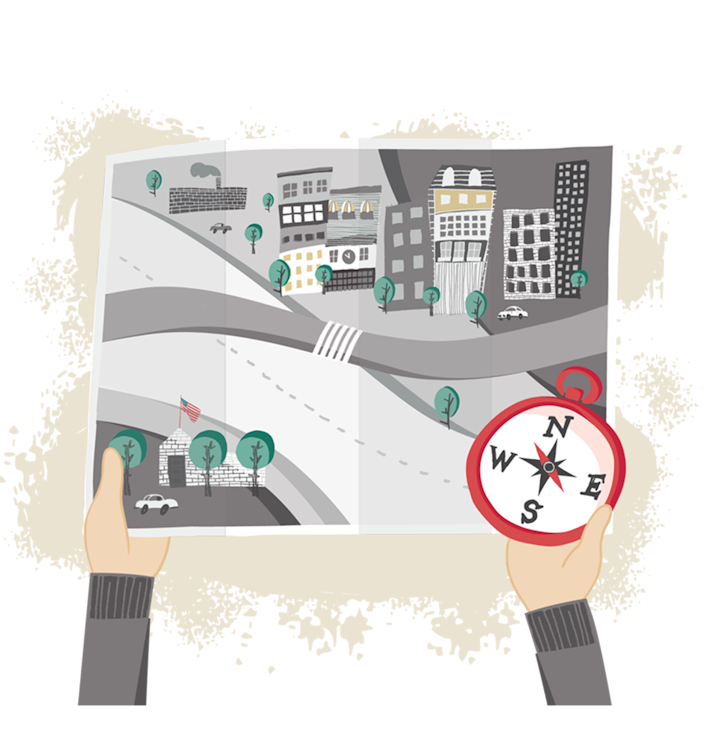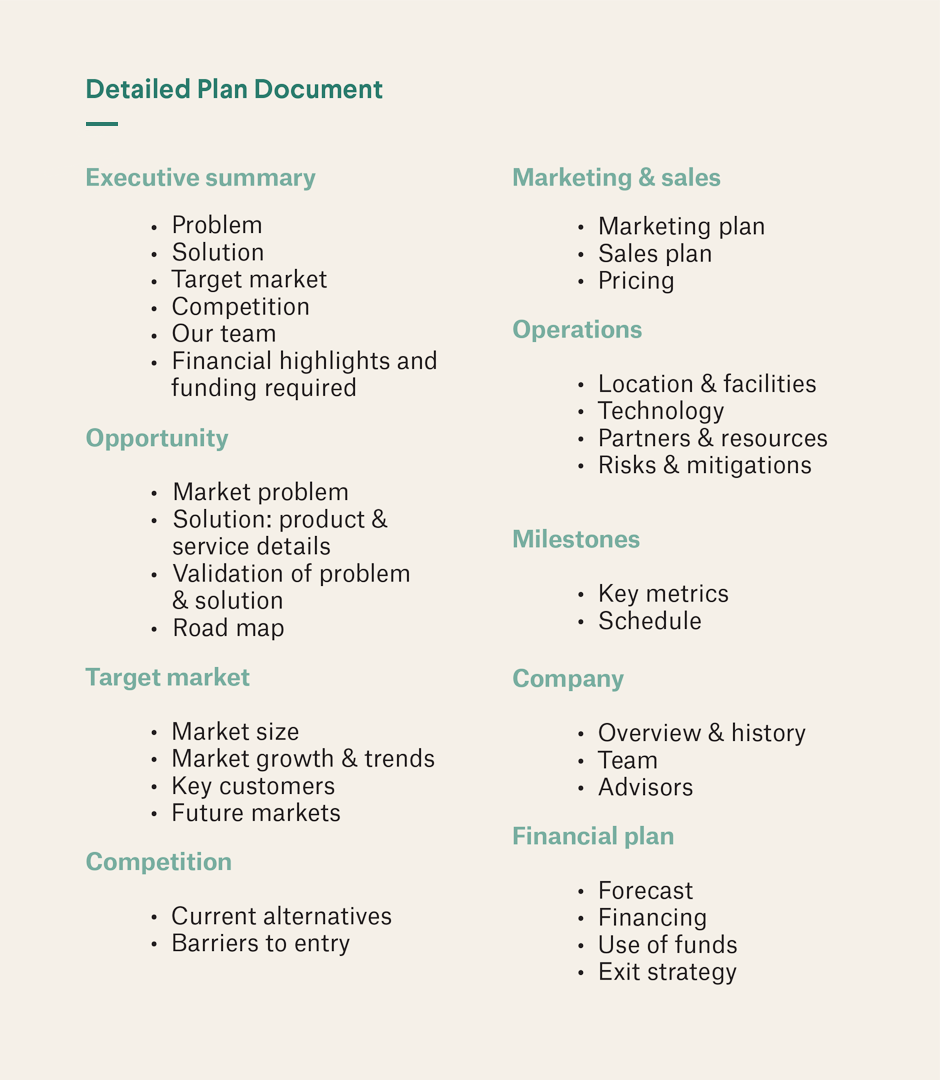How to write a business plan
Planning your route can be as fun as the actual journey

by Emanuela for 99designs

Ugh. You’ve probably heard it from every startup and small business advisor out there, “You need a business plan.”
When I first got this advice, I immediately thought of all the ways I could put this task off: I could design my logo first. Then I could figure out online payments. Then I could clean out my garage…
I imagined that “planning” was like writing a high school term paper on that book I didn’t read—and put it off until I didn’t have a choice but to just stay up late with the Cliff’s Notes and get it done.
Well, it turns out that business planning isn’t like writing a term paper—I was dead wrong. Business planning is fun and simple, like prepping for your next road trip. Figuring out how you’re going to find that perfect deserted beach, pina colada in hand, is hardly ever a chore, and business planning doesn’t have to be either.
Don’t swallow that obsolete idea that a business plan needs to be a long, formal document. Planning isn’t that way anymore. Instead of some term paper that you need to turn in for a grade, planning is the perfect guide that gets you and your business where you want to go. It’s Google Maps plus an experienced concierge guiding you to success, instead of the hard-to-read, improperly folded maps stuffed into the seat pockets of your car.
Today, I’m going to walk you step-by-step through the business planning process and teach you how you can get your plan done in under an hour. It’s easy, I promise. But first, just a few words on why you should spend a little time planning.
It’s a proven fact that business planning will make you more successful
I’ll save you the time of reading hundreds of academic research papers—I did that for you and the results are in: spending time on business planning greatly improves your chances of success. In fact, businesses that plan grow 30% faster than businesses that “just wing it” and hope for the best.

Everyone needs to row in the same direction
When you’re starting a business, you have a vision for what you want your company to be. You might be starting in the proverbial garage—or maybe your dorm room—but you have hopes and dreams for your business: perhaps a corporate campus in Palo Alto or maybe all the time off you need for traveling the world and with your family.
Whether you’re trying to build the next multinational corporation, or the best bakery in town, there’s a vision in your head about where you want to end up and how you want to get there. But, without a plan, you won’t know what it’s going to take to get there. It’s like plugging a destination into your GPS then turning the device off and hoping you arrive where you want.
Doing a little bit of planning gives you the turn-by-turn route. And sharing those directions with your team gets everyone on the same page, understanding your strategy. Without that plan, you may find your marketing team emphasizing cost savings and simplicity while your sales team is trying to sell expensive customization services. Everyone’s going in different directions and nothing is effective.
If you’re raising money, you need to know your stuff
Sitting in a fancy conference room, at a mahogany table that costs more than your car, and getting peppered with questions from potential investors is tough. I’ve been there. And it’s even harder when you don’t know the answers to those questions.
If you’re considering raising money from investors, you’re going to need to know your plan. Investors are going to want to know how you plan on building your company, what your marketing plan is, how you plan on acquiring customers and much, much more.
You’re going to need to know your sales forecast and expense budget backwards and forwards as well as your strategy for getting your business where you want to go.
Without planning, you simply won’t know the answers to those questions.
(Bonus tip: Even if you’re not raising money, you still need to know your stuff if you want to be a success.)

How to get your business plan done in under an hour
When you’re thinking about starting a business, do you ever jot down a few notes on a napkin? Congratulations—you’re planning! Not that hard, is it?
Well, you’ll probably need a little more than that napkin sketch to complete a full planning process. But, it’s a good reminder that planning is for you and your business. It’s not for someone else. You start simple and grow your plans as you need to. You don’t do anything that doesn’t have a purpose.
So, for example, if you’re not presenting your plan to outside investors, you probably don’t need to spend time writing out an exit strategy or describing your management team in detail.
In business planning, form follows function: skip the detailed printed plan unless investors ask for one. Instead stick to a simple presentation and some financial spreadsheets.
I recommend starting with a simple one-page business plan and expanding this plan as you need to. I like to call this one-page business plan a “pitch” because it’s a great tool for sharing your business idea with friends, family, and investors. And, it’s easy to complete—you’ll be able to get a draft done in under an hour. You’ll get your business strategy finished and you can easily update it as you learn more about your business.
A simple planning process also means that you can experiment with multiple business ideas in a single afternoon and find a business model that works for you!
What to include in your plan
When you start your planning process with a simple “pitch,” try and imagine that you’re writing for Twitter and keep each section as short and concise as possible (tho mb u shuld skip SMS-speak?). Here’s what you need to include:
- Value proposition: Describe your business in one sentence. What do you do and what value does it give your customers?
- Market need: Your customers have a problem (a “need”) and your business solves that problem. What’s that need?
- Your solution: This is your solution to your customers' problem. How does your product or service solve that problem?
- Competition: What do your potential customers do today instead of using your product or service? How are you better or different than those alternatives?
- Target market: Who is your ideal customer and how many of them are there?
- Sales and marketing: How do you market your products and services to your customers and what’s the sales process like?
- Budget and sales goals: Do a basic sales forecast and expense budget. If you’re starting a business, you need to know if you can make a profit, if not right away, eventually. As needed, expand your financial forecast to include a cash flow statement, balance sheet, and profit and loss statement.
- Milestones: If you’ve already started your business and have achieved some key milestones, what are they? Otherwise, what key tasks do you need to accomplish and when?
- Team: Even if you don’t know who specifically is going to help you start your business, write down the key positions you’re going to need to hire.
- Partners and resources: If you need to work with other companies to make your business work, highlight those here. If you don’t need any external resources, you can skip this section.
- Funding needs: Optional. If you don’t need funding to start your business, just skip this. Otherwise, figure out what you need to get your business off the ground. Your financial forecast will help you here.
A more detailed option
At some point, you may need more detail than this. Use your pitch as a starting point for a more detailed planning document and use each pitch section as a chapter in the business plan document. Summarize the plan with an executive summary. You could even use your pitch for that. Here’s a quick run-down of what a more detailed plan document might contain:
You can download a business plan template here.
Please don’t think that you have to do all of this to get value from business planning. Planning is about the process of thinking about your strategy, not about producing a long document. For many people, a simple pitch and financial forecast is more than enough. Use the document format above only if you need to add and share more detail than the pitch can contain.

How to make your business plan work for you
As Mike Tyson famously said, “Everyone has a plan ‘til they get punched in the mouth.”
That doesn’t mean that you shouldn’t plan. It means that you need to start out with a plan and then be ready to change and adapt as you learn more about your customers, their needs and how they want to buy from you.
Once you start making money and spending money, it’s critical that you track your progress towards your goals. Are you meeting your sales goals? Are you staying on budget? Why or why not?
The most important part of planning is to schedule a regular time to review and check in on your progress towards your goals and then adjust as needed. If you aren’t meeting your sales goals or if you’re not staying on your budget, dig into the details and find out why. Without a plan, you won’t have the tools to know if things are going well or going badly.
The thing about business plans is that they’re accurate for about six hours.
Once you start actually talking to your customers and building your product or developing your service, it may turn out that your assumptions are wrong and you’ll have to change course. As your plans change, update your pitch with your latest knowledge and information so you can adjust your strategy.
Planning isn’t about creating the perfect document, it’s about setting goals and documenting your best guesses on how you’re going to reach those goals. Sometimes you may end up on a detour, but who knows, maybe that winding path will lead you to a hidden beach with a tiny hut that makes the best piña coladas you’ve ever tasted.

Article provided by LivePlan. LivePlan is the world's leading business plan software, built for entrepreneurs like you.
Design tips & business trends in your inbox?
Like what you've read? Sign up for our newsletter!
We'll also send you the occasional marketing email and promotion (which you can opt-out of anytime).
Lucky! You just got some insane discounts.
You proved us right again. Our newsletter is only for the coolest kids. And you’re one of ‘em. Get ready for amazing stuff in your inbox.
